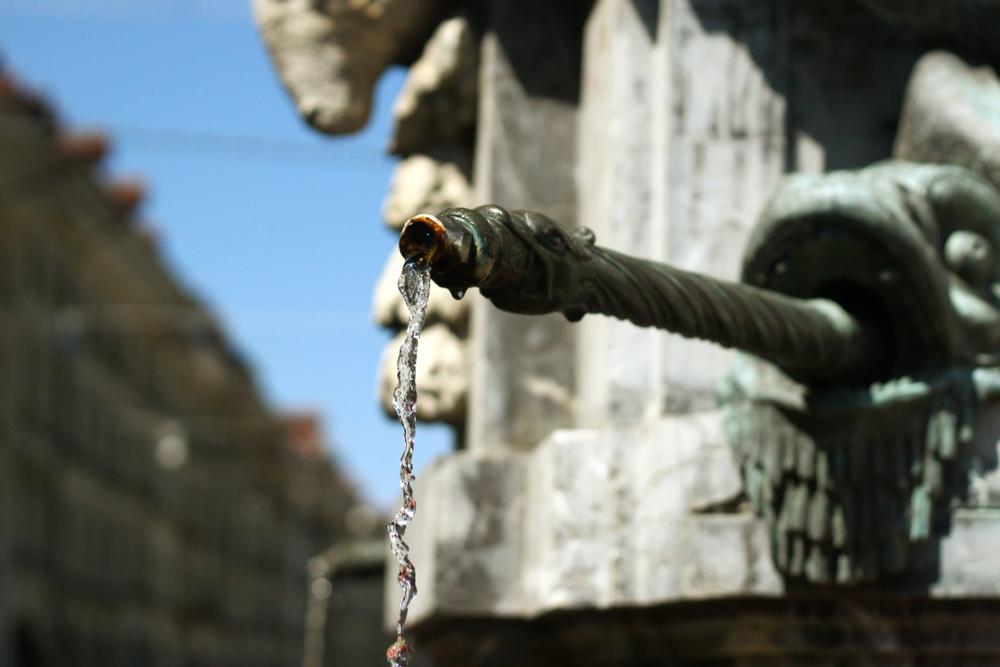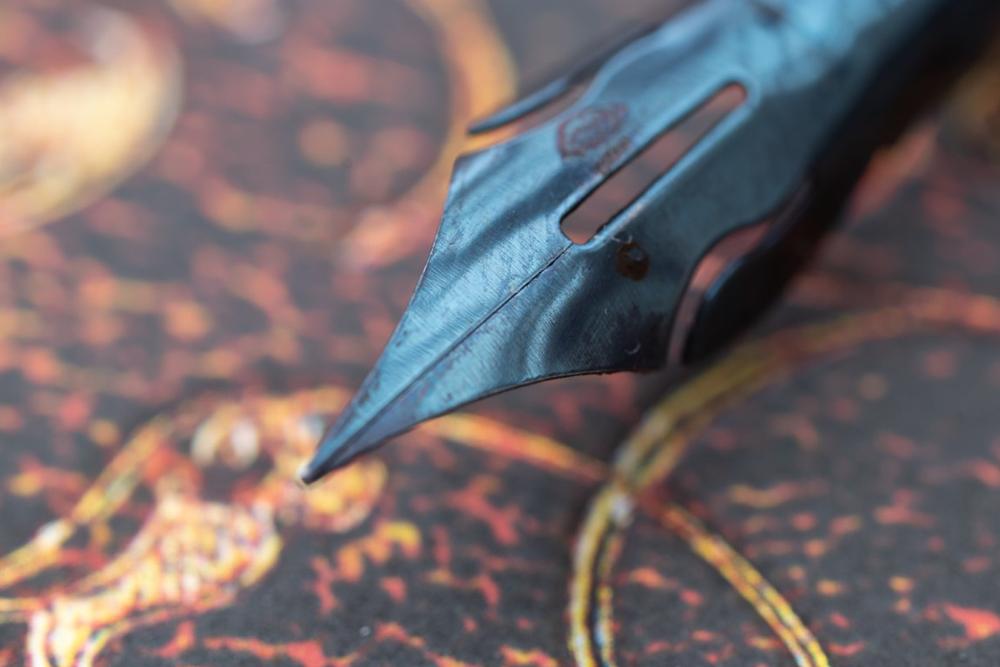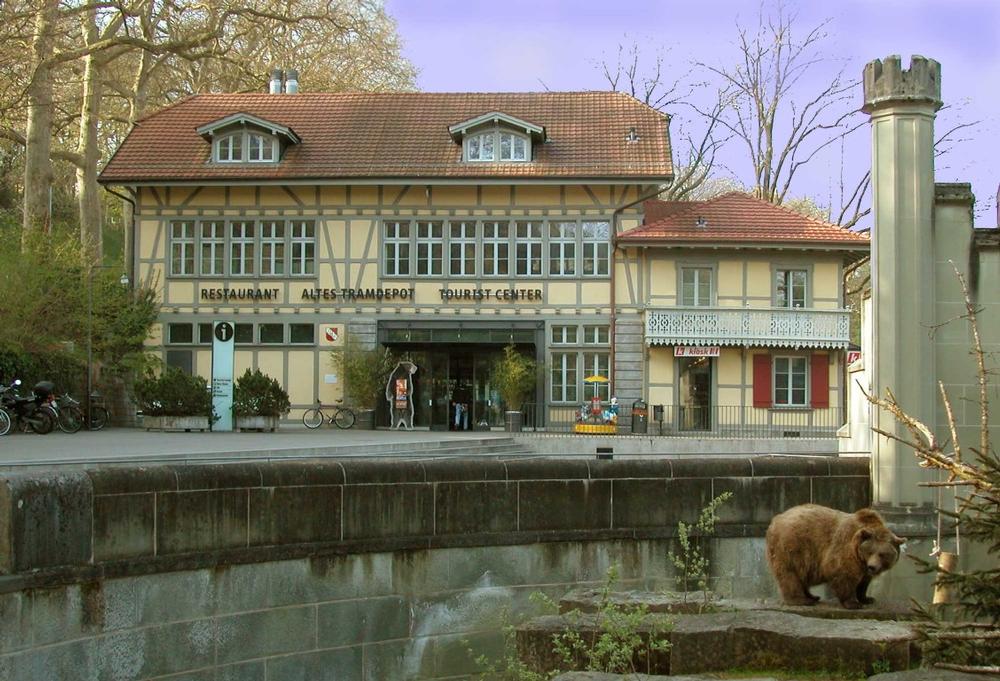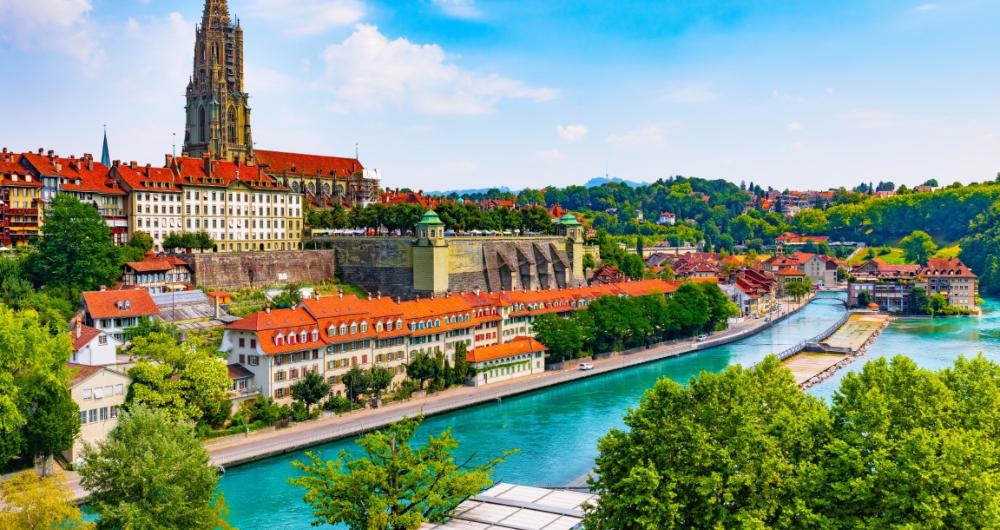In This Article
Looking for medieval charm with modern flair in the heart of Switzerland? Head to Bern! The Swiss capital is a picturesque city of cobbled streets, sandstone buildings, and the winding Aare River. Whether you’re exploring the UNESCO-listed Old Town, swimming in the river, or enjoying Swiss chocolate and mountain views, Bern is a cultural gem with laid-back elegance.
Bern, Switzerland Highlights:
- Stroll through Bern’s Old Town (Altstadt): A UNESCO World Heritage Site filled with arcades, clock towers, and 16th-century fountains.
- Watch the Zytglogge Clock Tower Show: See the famous astronomical clock strike the hour with animated mechanical figures.
- Visit the Bundeshaus (Federal Palace): Take a free tour of Switzerland’s parliament building overlooking the Aare River.
- Swim in the Aare River: In summer, locals float down this crystal-clear river for a uniquely Bernese experience.
- Explore the Rosengarten: A peaceful rose garden park with panoramic views over the Old Town and the Alps beyond.
When I like to visit Bern, Switzerland
The best time to visit Bern is from late spring to early fall (May to September). These months offer mild weather perfect for walking tours, river swims, and open-air dining. Winter (December–February) brings festive Christmas markets and access to nearby ski resorts.
Tips for getting to Bern, Switzerland
- By Train: Bern is well connected via Switzerland’s efficient rail system, about 1 hour from Zurich, Basel, or Lausanne.
- By Air: Fly into Bern Airport (BRN) or nearby Zurich (ZRH) or Geneva (GVA), then take a train to Bern.
- By Car: Highways A1 and A6 connect Bern to major Swiss cities and regions.
Where I like to stay in Bern, Switzerland
- Hotel Schweizerhof Bern & Spa – Luxurious 5-star stay in the city center with elegant rooms and a rooftop terrace.
- Kreuz Bern Modern City Hotel – Comfortable, stylish hotel just steps from the Zytglogge and restaurants.
- Hotel Landhaus – Budget-friendly boutique hotel in a quiet riverside neighborhood with vintage flair.
Best Things to Do in Bern, Switzerland
1. Marvel at Artistry and History at Bern’s Fountains

© Pietersma/stock.adobe.com
-
How has water influenced the development of Bern?
-
The availability of abundant water supplies has played a significant role in the growth and development of Bern.
-
How many public fountains are there in Bern?
-
Bern has more than 100 public fountains, which were once the city's main source of household water and places for social interaction.
-
What purpose do the fountains serve today?
-
Today, Bern’s fountains provide free drinkable water to both residents and visitors.
-
What were the original fountains in Bern made of?
-
The original fountains were made of wood but were replaced in 1550 by stone works of art.
-
What figures are depicted in the fountains?
-
Many fountains depict allegorical figures such as Justice and the Ogre.
-
Others depict biblical figures like Moses and Samson.
-
Do the fountains serve any functional purpose besides providing water?
-
Yes! Some fountains are located in the middle of busy streets and act as traffic calmers.
-
Are there guided tours related to Bern's fountains?
-
Yes! Visitors can join water-themed walking tours to learn more about the historical and artistic significance of Bern’s fountains.
2. If You Love Gothic Architecture, Climb the Bern Cathedral

© Pietersma/stock.adobe.com
-
What is the Bern Cathedral?
-
Bern Cathedral
is the largest and most important late medieval church in Switzerland.
-
What is the function of the Bern Cathedral?
-
It is a functioning parish church and dominates the landscape of Bern.
-
When was the current Bern Cathedral built?
-
In 1421, when Bern was on the ascendancy as a city-state, the current church was built around the existing church, which was then torn down.
-
What is significant about the stained glass windows?
-
The stained glass windows, depicting the Passion, date back to 1441.
-
What happened during the Reformation in 1528?
-
Most of the decor was removed and destroyed.
-
What statues were rediscovered in 1986?
-
Statues that were used as filler when the terrace was built were rediscovered in 1986.
-
What happened to the organ?
-
The organ was silent for 200 years after the Reformation but has been restored to working order.
Münsterplatz 1, 3000 Bern, Switzerland, Phone: +41-3-13-12-04-62
3. Step Into the Mind of a Genius at Einstein House

© Krisztian/stock.adobe.com
-
Where did Einstein live and study in Bern?
-
Einstein, a German-born theoretical physicist, lived and studied in Bern from 1902 to 1909.
-
What is the Einstein House?
-
Einstein House is a joint initiative between the American and European Physical Societies and was declared a Historic Site in 2015.
-
Where did Einstein and his family live in Bern?
-
He and his wife and son occupied the second-floor apartment for 2 years.
-
Where did Einstein develop his Theory of Relativity?
-
It was in this apartment that he developed his Theory of Relativity.
-
What has been restored in the Einstein House?
-
The apartment and the spiral stairs leading to it have been restored to reflect the period.
-
What can visitors see on the third floor?
-
On the third floor, there is an exhibition of Einstein's life and works.
-
What does the Zytglogge clock tower tour explore?
-
A tour of the Zytglogge clock tower, with its 15th-century astronomical clock, explores Einstein's concept of time.
Kramgasse 49, 3011 Bern, Switzerland, Phone: +41-3-13-12-00-91
4. Admire Masterpieces at Kunstmuseum Bern

© Kunstmuseum Bern
-
Where is the Museum of Fine Art housed?
-
The Museum of Fine Art is housed in a late 19th-century Renaissance Revival building.
-
How many items are in the museum's collection?
-
There are more than 50,000 items in the museum's collection.
-
What does the permanent exhibition showcase?
-
The permanent exhibition chronicles Swiss and international art from the Middle Ages to the present.
-
Which famous artists have works in the museum?
-
There are works from Cézanne, Matisse, Chagall, van Gogh, Picasso, Dalí, Monet, and others.
-
What is the Gurlitt Collection?
-
In May 2014, the museum was offered the controversial Gurlitt Collection, parts of which were thought to have been looted during Hitler's regime.
-
What types of works are in the Gurlitt Collection?
-
Approximately 1,500 works, including old masters and examples of Expressionism, Impressionism, and Cubism, were accepted and exhibited in 2018.
-
Where is the Kunstmuseum Bern located?
5. Explore Swiss Politics and Pride at the Bundeshaus

© eyetronic/stock.adobe.com
-
When did work begin on the parliamentary buildings in Bern?
-
Four years after Bern was declared the capital of Switzerland, work began on the parliamentary buildings.
-
How was the parliamentary complex built?
-
The 300-meter complex was built in three phases.
-
When were the different sections completed?
-
In 1852, work on the west wing began, and in 1884 the mirror image east wing was completed.
-
When was the central section finished?
-
The central section, with its 64m high copper dome, was completed in the early 1900s.
-
How many artists contributed to the decoration?
-
Thirty-eight artists contributed to the interior and exterior decoration.
-
What did the Swiss Association for the Blind and Visually Impaired donate in 2018?
-
In 2018, the Swiss Association for the Blind and Visually Impaired donated a 1:130 scale model of the building to the city, for the public to touch.
-
Where is the bronze cast model located?
-
The bronze cast model is situated behind the buildings.
-
Where is the Bundeshaus located?
6. Discover Contemporary Art at Kunsthalle Bern

© Kunsthalle Bern
-
When was the Kunsthalle Bern established?
-
This large art exposition hall, on Helvetiaplatz, was established in 1917 by the Bernese Artists' Society.
-
What is the aim of the Kunsthalle Bern?
-
The aim of the institution is to forge new paths in art by exhibiting contemporary art and stimulating discussion on social issues and aesthetics.
-
Why did the Kunsthalle Bern gain prominence in 1969?
-
It came to prominence in 1969 due to a themed exhibition, entitled 'When Attitude Becomes Form'.
-
How many exhibitions does Kunsthalle Bern host annually?
-
There are between six and seven group and individual exhibitions per annum, featuring well-known and new Bernese, Swiss, and international artists.
-
When was the Kunsthalle Bern Foundation formed?
-
The Kunsthalle Bern Foundation was formed in 1988 by collectors of contemporary art, in order to purchase relevant artworks.
-
What types of events does Kunsthalle Bern offer?
-
The Kunsthalle offers public tours, lectures, and debates.
-
Where is the Kunsthalle Bern located?
Activities and Attractions for Couples:
7. Travel Through Time at the Historical Museum

© schankz/stock.adobe.com
-
When was the Historical Museum built?
-
The Historical Museum was built in 1894 but modeled on castles of the 15th and 16th centuries.
-
When was the glass-fronted extension added?
-
A glass-fronted extension was added in 2009.
-
What is the goal of the museum?
-
The museum seeks to present the grand sweep of history from the Stone Ages to the present day.
-
How many objects are in the museum's collection?
-
More than half a million objects chronicle world history, inter alia, through archaeological finds, ethnography, and numismatics.
-
What do the permanent exhibitions focus on?
-
Permanent exhibitions focus on Bern's highs and lows, its captured treasures, and its current status.
-
What types of temporary exhibitions are held?
-
Temporary exhibitions include diverse themes such as man's migration and Nativity scenes from around the world.
-
How much space is dedicated to Einstein?
-
A 1000 square meter space is devoted to the life and work of Einstein.
-
Where is the Historical Museum located?
-
Helvetiaplatz 5, CH-3005 Bern, Phone +41-3-13-50-77-11
8. Savor Local Brews with a View at Altes Tramdepot

© Altes Tramdepot
-
What is the Altes Tramdepot?
-
As its name suggests, this brewery and restaurant are housed in a former tram depot.
-
When was the building constructed?
-
The building dates back to 1889 and is situated on the Aare River, with views of the Bärenpark from the summer terrace.
-
Where is the brewery located within the restaurant?
-
The brewery is in the center of the restaurant and brews several times a week.
-
How much beer does Altes Tramdepot produce annually?
-
It produces more than 3000 hectoliters of perennial and seasonal beers each year.
-
How many people can the restaurant accommodate?
-
The restaurant can seat 500 people in four sections, including a hall and a beer garden.
-
Are guided tours available?
-
There are guided tours daily, with more in-depth information sessions on Saturdays.
-
What events are held at the brewery?
-
Regular talks on Swiss beer and other spirits are held at the brewery.
-
Where is the Altes Tramdepot located?
-
Altes Tramdepot,
Grosser Muristalden 6, CH-3006 Bern, Phone: +41-3-13-68-14-15
9. If You’re Fascinated by Modern Art, Visit Zentrum Paul Klee

© Simon Ebel/stock.adobe.com
-
Who was Paul Klee?
-
Paul Klee was an artist in the Expressionist, Cubist, and Surrealist genres.
-
What were Paul Klee’s other interests?
-
He was an avid reader of literature and studied fine art.
-
What was Paul Klee known for in his artwork?
-
He was commended on his line work but felt that he struggled with color.
-
What did Paul Klee write about?
-
He wrote books on aesthetics, color, and art theory.
-
Where did Paul Klee teach?
-
He taught design and architecture at the Bauhaus School of Art.
-
What does Paul Klee’s diary reveal?
-
Paul Klee kept a diary from 1897 to 1918, which reveals his dry, often childlike humor.
-
What is housed at Zentrum Paul Klee?
-
The Center (Zentrum Paul Klee) has more than 4000 of his paintings, aquarelles, and drawings, spanning his entire career.
-
What additional facilities does Zentrum Paul Klee offer?
-
There is a creativity area for children, an auditorium for musical events, and various venues for seminars.
-
Where is Zentrum Paul Klee located?
-
Monument im Fruchtland 3, 3000 Bern 31, Phone +41-3-13-59-01-01
Where I Like to Eat in Bern, Switzerland
- Restaurant Rosengarten – Dine with breathtaking views over the city and enjoy seasonal Swiss cuisine.
- Kornhauskeller – Elegant eatery in a former wine cellar, serving classic dishes in a dramatic setting.
- Altes Tramdepot – Brewpub offering house-made beers and hearty meals with views of the Bear Park and Old Town.
My favorite local events:
- Bern Carnival (Fasnacht) (February/March) – Traditional Swiss celebration with costumes, parades, and confetti-filled fun.
- Buskers Bern Street Music Festival (August) – International performers take over the streets with music, circus, and art.
- Zibelemärit (Onion Market) (November) – Unique folk festival where thousands of decorative onions are sold alongside music and mulled wine.
My favorite day trips within 30 Minutes to 2 Hours of Bern, Switzerland:
- Thun (30 min) – A lakeside town with a castle, historic old town, and boat tours on Lake Thun.
- Gruyères (1.5 hrs) – Tour a medieval hilltop village, Gruyère cheese dairy, and the quirky HR Giger Museum.
- Lucerne (1.5 hrs) – Visit the iconic Kapellbrücke (Chapel Bridge), lakefront promenades, and mountain views.
- Interlaken (1.5 hrs) – Gateway to the Bernese Alps, great for adventure sports and scenic trains to Jungfraujoch.
- Laupen (45 min) – Small, quiet town with a romantic castle and countryside walks off the beaten path.
Plan Your Trip











